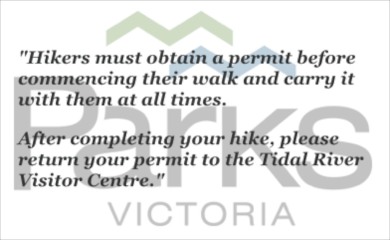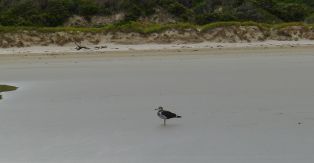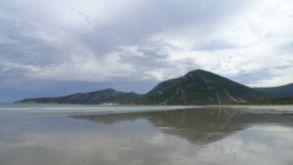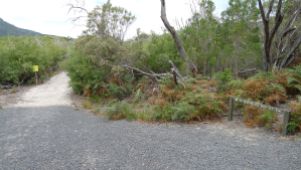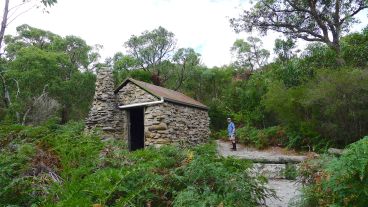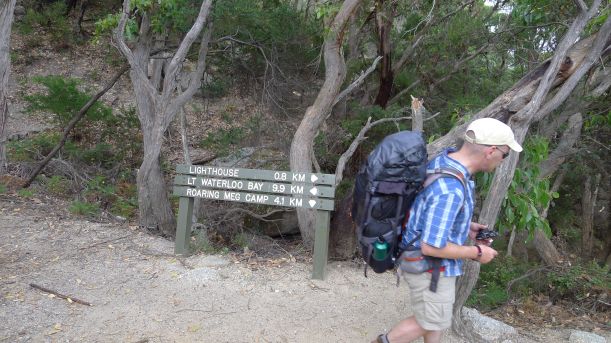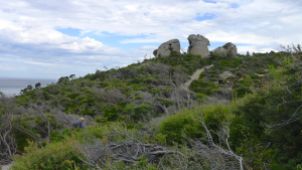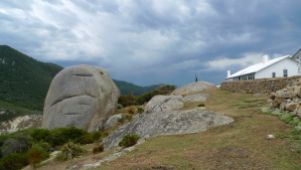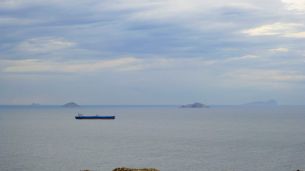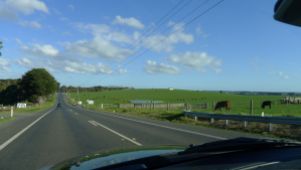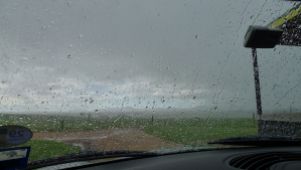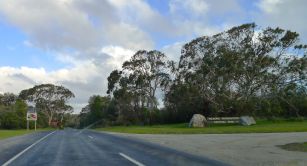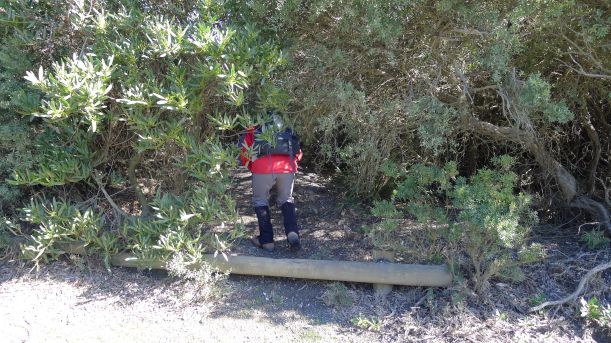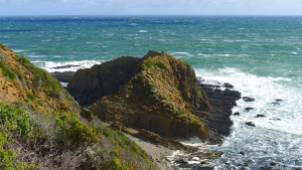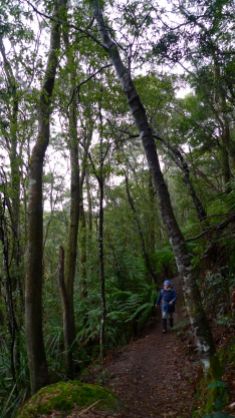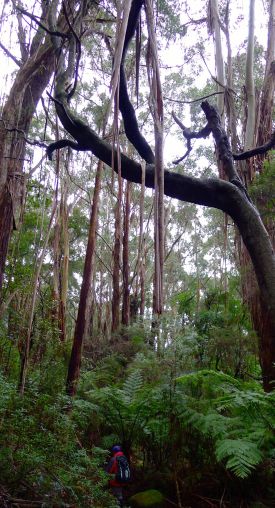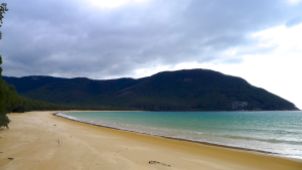Last August we left Wilsons Promontory Nation Park (aka “The Prom”) with a sense of frustration that we couldn’t explore very much of the park in one-day-return walks. This had to be amended.
There are two multi-day circuits you can walk in the park – northern and southern – that have campsites spaced at reasonable distances along the way. I’ve read that the southern circuit is the more popular, easier and better defined of the two. The southern circuit also includes optional side walks to mainland Australia’s most south-eastern point and most southerly point; both of which we hoped to bag on this trip.
With the added lure of being able to stay at the lightstation at the south-eastern corner, a mere 20km (roughly) from Tidal River, plans were made to return. It would mean at least two days of long walks to get there and back, but if that’s what it was going to take, then so be it. As mentioned in my previous post we aren’t equipped for camping which is why this would be an all-or-nothing dash between Tidal River and the Lightstation (and back again). If we were also camping we’d probably do it as a 4 or 5 night walk, and travel only half the distance each day that we did.
In preparing for the walk we found there to be a lack of detailed information about both the walk and the accommodation at the lightstation from Parks Victoria – or maybe the information provided is of usual standard and we were just nervous first-timers. I’m not sure.
In any case, we already had an SV Map from our previous visit (see August 2013 Part 1 & Part 2) which, while not quite pocket size, actually gives you the type of information that is of greatest benefit when preparing for walks; trivial details like contour lines, distances between points, landmarks etc – the kind of details you don’t get on Parks Victoria’s maps. Perusing photos shared on Google Maps will convince you that taking your camera along is a good idea (if you weren’t already planning to do so), but likewise doesn’t greatly assist in giving you much of an idea of what to expect along the way.
For the accommodation side of things, the greatest insight (and a large part of the inspiration) was provided by Greg of Hiking Fiasco fame who visited the lighthouse back in 2009. (Note: his photos are from Cottage 5 which currently sleeps about 10 people.) It was this post of Greg’s that lead me to embark on creating our own menu of hiking food – see previous post.
Therefore, our goals for this expedition were twofold:
1. to make it to the lighthouse & return again safely
2. to take enough photos to support a detailed blog post to help anyone else planning to walk to the lighthouse for the first time get a better idea of what to expect
Day 1: Tidal River to Wilsons Promontory Lighthouse (South East Lightstation)
via Oberon Bay Walking Track then Telegraph Track
Having driven down from Melbourne the day before, Black Cockatoo’s studio cottage (just oust side the park in Yanakie) was ‘base camp’, allowing us to enjoy a good night’s sleep before rising early and excited, ready for our first big day of walking.
You can’t pass up the opportunity to take a few photos of the sunrise when it presents itself like this, though.
We’d weighed our packs before leaving home. Despite last minute culling of one or two more items that morning, with the addition of our water bottles mine would have weighed 16.5kg or so and Stephen’s was about 18kg. Ooof!
It was a quiet drive down to Tidal River; not too many people on the road, and no wildlife either. There’s no point being too early, as the Visitor Centre doesn’t open until 8:30am. We arrived at about 8:45am, presented ourselves with booking confirmation at the main desk and were given a sticker to display inside the car’s windscreen. Despite the Parks Victoria website suggesting that we’d need to collect a permit (each?):
…nothing was given or mentioned. We were asked to check in again on our way out – and then we were free to go! I asked if there were any track issues we should be aware of, but apparently there are none at present.
By the time we put our boots on, packed up the car and made a last comfort stop it was 9:15am. Well and truly time to head off.
Note: The shortest path to the lighthouse is to drive to the top of Telegraph Saddle (Oberon) Carpark, leave your car there (only Parks Victoria vehicles are allowed further), and follow Telegraph Track the whole way down. The shortest possible route (per our SV Map) indicated that to be 17.9km. We did not chose this option because:
(1) Stephen had read comments suggesting that it is less safe to leave your car up at the saddle carpark (and we like the Mini just as it is) so parking it right outside the Visitor Centre & police station (though we’ve never seen signs of police actually there – possibly it’s a peak season thing) seemed like the safest choice; and
(2) We’d read that the Telegraph Saddle Track is a bit boring, so walking the whole length in one go was not too appealing. The original plan was to return on Day 3 from the lighthouse via the South East Walking Track, taking the Waterloo Bay Walking Track back to Telegraph Junction, return to Tidal River over the Telegraph Saddle and see what we’d missed out on (but with lighter packs by then).
By choosing to leave the car at Tidal River, we then had the options of two routes to get to Telegraph Junction:
– either by taking the undulating and varied Oberon Bay Walking Track around the west coast to Oberon Bay
– or heading inland and walking up and over Telegraph Saddle to follow Telegraph track the whole way.
The Oberon Bay Walking track option is 1.4km longer, but on the other hand you avoid a climb of approx 200m (with full and heavy packs) at the outset. We chose Oberon Bay Walking Track.
Note that there is a shuttle bus service up to Telegraph Saddle but it doesn’t operate during the week, only during peak periods when the Telegraph Saddle (Oberon) carpark is otherwise closed to private cars (see more about the shuttle bus service here).
Thus, this was the elevation profile for our walk to the lightstation:
Oberon Bay Walking Track (very glamorously) starts behind the toilet block between the Visitor Centre and the General Store at Tidal River. This path is well formed and well travelled, and provides lovely beach views as it climbs up to Norman Point and around to Little Oberon Bay.
(I have added in a couple of track photos from August – just convince you that it’s not all calm conditions and sunshine there!)
There’s a short stretch of beach to cross at Little Oberon Bay. (What a beautiful place this is!)
Just after you cross the line of rocks bisecting the beach, look for a mass of footprints that leads up to the shelf above the beach. There’s a yellow sign indicating where the track continues on.
And that’s not the trickiest one in the park by a long shot. Here’s a closer photo so you know what you’re looking for, not just roughly where.
This is a very well beaten path, still being within pretty easy walking distance of Tidal River, but if the weather has wiped out the dozens of footprints usually there to follow, look for the line of rocks indicating the path.
The track around the next headland is very similar to the one around Norman Point. It was along here that I was intrigued to see, and count myself lucky to have got the chance to photograph, a white-lipped snake.
My copy of “Australian Reptiles and Amphibians” (Leonard Cronin, 2001) advises that the White-lipped Snake (Drysdalia coronoides) is venomous but not dangerous. Although they may grow to 50cm long, this one was only about 20cm, I’d say. And if you’re wondering what they eat…
…skinks, skink eggs, frogs and even small mammals are all potential prey.
By now Oberon Beach was in sight. We’d checked ahead and knew the tide would be pretty low when we got to Growler Creek, meaning getting wet feet was highly unlikely. Keep in mind too, that there hasn’t been any rain (or meaningful rain) for the last couple of months.
We hadn’t walked along Oberon Beach before, so weren’t exactly sure where the turn off was. I thought it was at the end of the beach, but was hoping for another bright yellow sign to show the way. So we kept walking, taking photos and looking for a bright yellow sign…
I was slightly wrong. We overshot by a couple of hundred metres. The track to/from the beach is on the northern side of Fraser Creek, and indicated by the usual wooden green Vic Parks sign but it’s not accompanied by a yellow high-visibilty-type sign that we were looking for. Which is why I’ve adulterated this next photo, in the hope that it may help someone else avoid our mistake. Frasers Creek is only about 1km along from Growler Creek, and you should look for the signed path through the low dune just north of Frasers Creek, which itself is pretty obvious.
After about 30m there is a nice new composting toilet at the turn off to the camping ground. The track to Telegraph Track continues for 3.5km eastward on a pretty sandy, mildly undulating, vehicle track.
It was getting noticeably warm by this point. There wasn’t a lot of breeze today, and walking through the valley floor I was wondering how stifling it could get through here in the height of summer (usually mid January to the end of February)…
We finally made it to Telegraph Junction. It felt like a long 11km from Tidal River. Mind you, I couldn’t get my back pack to settle comfortably, and the day really seemed to be hotter than the predicted 23oC, which wasn’t helping.
There is probably about 30m (max) between where the Oberon Bay Walking Track meets the Telegraph Track from the west and where the Waterloo Bay Track meets up from the east. This area is known as Telegraph Junction.
Telegraph Track is (currently) a very well made and maintained maintenance road running from Telegraph Saddle (Oberon Carpark) to about 3km from the lightstation. The park rangers at the lighthouse drive this road to start/finish their weekly shift. It makes for sure footing, but it’s also pretty hot and exposed.
Just 1.8km along from Telegraph Junction, but already feeling like a fair way higher up the hill, Halfway Hut was a great location for a brief lunch stop just off the side of the road (there is also a camping area nearby).
The further we walked, the more I was convinced that it was hotter than 23oC – Stephen later found out from one of the park rangers that it got up to 30oC. But knowing that at the time wouldn’t have helped. You have to be mindful of how much you’re drinking and just keep putting one foot in front of the other.
But damn it was a long, hard slog up that road on the slopes of Telegraph Hill and past Martins Hill!
After many false summits we were finally at the top of the track by Martins Hill. The vegetation’s quite cleared up there as it’s also a helicopter landing area (according to our map). I didn’t feel the relief though. All I could think about was drinking long glasses of lemon effervescent drink (currently in powder form in my pack) once we finally made it to the lightstation – still a long way off – and meanwhile my pack wasn’t getting any lighter.
Here at the top of the hill is the start/end of an alternative walking track route that is 200m longer than the management track. We decided to stick with the vehicle track thinking it’d be a better grade and possible quicker. (Much earlier in the walk, when we were heading up to Norman Point, Stephen had an small accident that resulted in a skinned knee. This influenced a couple of track choice decisions.)
I’d like to say I took the opportunity to enjoy walking downhill for a while, but I confess the main thought on my mind was, ‘If we come back up this road [i.e. taking the shortest way back, which seemed more than likely at this point] it’s going to be another looong slog.”
The tall trees and ferns in the gullies here are lovely, and in any other circumstance I’d probably have been delighted to be walking there, but under the circumstances I didn’t appreciate it as fully as it possibly deserved. The shady parts were wonderful, but surely all this downhill walking meant that soon we would see some sign that we were getting close to the end of the promontory? Unfortunately, there is no glimpse or even hint of your goal (or even the ocean) until you’re practically upon it, and that’s not for half a dozen kilometres yet. There’s nothing but the neighboring hills.
Probably less than 100m before you get to Roaring Meg Creek at the bottom of the hill is an intersection that I shall refer to as ‘Roaring Meg Junction’. Here is the turnoff to Roaring Meg campsite and also the track to South Point, the inventively named most southerly point on the Australian mainland – a destination I had originally hoped to bag the following day, but one that was looking increasingly unlikely (this trip). It’s also at this junction that the bushwalking track that we could have taken back up at the top near Martins Hill joins back to the management track. Another bushwalking track option starts – this time it’s 1.1km shorter (2.3km vs 3.4km) to head off the road. The bushwalking track re-joins the management track 3.8km before the lightstation (per our SV Map).
It was at Roaring Meg Junction that we first met Neal (possibly Neil) and Elle (possibly El). They were also heading to the lighthouse but had chosen the shorter option of starting from Telegraph Saddle and had taken the bushwalker track from Martin’s Hill to this point.
We decided to continue on along the management track, and they chose the bush track. I was not over the moon with this decision, thinking that any track in the shade had to be 100x better than one with bugger-all shade and more hot, gravel surface reflecting the heat back up at me (keeping in mind it was 30oC, with out much in the way of a breeze for the most part), but it was the even surface that Stephen wanted (due to his knee).
It was slow going up along there.
One surprise on the way up that long rise was something every bushwalker should be mindful of, especially on warm days – a snake!
It was startled by Stephen who was a few metres ahead of me. A dark Tiger Snake (see also), a good metre or so in length, neck flattened, gave me a warning look and quickly moved off the road. “Holy Shit!!” was my startled exclamation.
A kilometre or so further along was another Tiger Snake (Notechis scutatus). Stephen, still walking in front, was the one to startle it, but this time saw it out of the corner of his eye and got a bit of a fright himself! I don’t think the snake saw me at first. It was lying across the road and watching Stephen.
Then it noticed me approaching!
I wasn’t sure how to pass. Not in front! Behind?
It took a few seconds (and given my dehydrated state, that’s not surprising) but I realised it wasn’t moving off like the first one did because it felt threatened – trapped between two giant (potential) predators it didn’t know what to do. The flattened neck was a bit of a give away. Once Stephen and I both backed off a few metres (it didn’t take much) the snake relaxed and within 15sec you’d have never known there was a snake there at all.
In the Visitor Centre back at Tidal River there is a sign warning that there are various species of snake in the park. I took this photo on our first trip to the park last August (of course, being winter we were much less likely to see a snake then).
Thank goodness both the Tiger Snakes we passed were only interested in disappearing into the bush. I had a couple of compression bandages once, but they got old and mouldy and haven’t been replaced. Our first aid kit has one standard length cotton stretch (crepe) bandage. We may have to do something about that. I had recently heard that the recommended treatment for snakebite had changed… I’ve now looked it up – here’s a link to St John Ambulance’s advice – which is pretty much as I remember it.
Neal and Elle told us later that although the bushwalking track is shorter, because it’s so steep (and small stones on the path make steep slopes sometimes feel like you’re walking on marbles) it’s not really the easier option.
At last you start heading downhill again and finally come to a couple of signs. The usual green-painted Parks Victoria sign with the hopeless blobby arrows on the right-hand side of the road indicates that the small dirt path on the left side of the road is the southern end of the South East Walking Track. A sign just ahead (on the left-hand side of the road) saying “No Through Road” convinced me that although the track off to the side looked like a goat track, it could actually be legitimate. I’m pretty sure the Parks Victoria sign didn’t say anything about the lightstation, but I failed to take a photo to check! Someone had helpfully scratched into the dirt of the road “Girls this way” with an arrow pointing to the small side track… With that ambiguous statement to ponder, we set off along what I really hoped would turn out to be the right path. Thankfully it was.
Finally you get to see your destination! It’s a fair way down from Telegraph Track.
At one of the turns, most of the way down, is the turn off from the South East Walking Track to the lighthouse.
If the small hill between you and the South East Point was man-made, then I would say it was a cruel joke. It’s steep, although (thankfully) reasonably short. There are also unmarked graves near the large ‘skull rocks’ near the top – they once had wooden markers, but they were destroyed in one of the bushfires that burnt out the promontory – the massive bushfire of 1951 I think we were told.
Just over the hill with the skull rocks is the helipad where supplies are flown in a few times a year. We saw Neal and Elle ahead of us, already walking up the last steep path to the lightstation.
Unlike many visitors (it seems), we had been forewarned about this bit, thanks to Hiking Fiasco. Knowing it was coming certainly helped mentally prepare for it, but it was even steeper than I’d given his story credit.
One…last…effort.
And then there was Renata, one of the Park Rangers welcoming me to the top, and Stephen with a freshly filled bottle of cold water (I had a mouthful but I was still hanging out for that effervescent drink).
We were shown around the old Lighthouse Keepers Cottage and met Colin, the other Park Ranger stationed here this week. We had room No 1 (perhaps because we were the first to book?) which is possibly the best, as it has it’s own door to the veranda and you can look directly out to the lighthouse (but the light doesn’t shine in of a nighttime). Finally we could drop our bags, take off the boots, find my bag of powdered saline drink and gulp down as much of the replenishing lemon-flavoured drink as I needed to feel somewhat recovered again. (Tip: you know you’ve had enough when it starts to taste less appealing.)
Once we’d rested for a few minutes, it was time for a wonderful hot shower, clean clothes, then to explore! (With a bottle of water in hand; re-hydrating properly can take a while.)
Truly, it wasn’t long before the pure bliss of being here totally washed away all the negative sentiments thought along the Telegraph Track. And then some.
I quickly decided I could happily live here. It’s not just because the walk back out seemed like a lot of effort (especially right now, having just walked 25km to get here), but because it was just perfect. Nice breeze, tall cliffs, lighthouse, ocean, offshore islands, tall, forested mountains, hardly anyone around – what more could you possibly ask?
How about seeing a wombat and her baby walking around the cottages? Well, we did.
Stephen’s very cleverly put together this collage of them.
Apparently there are about 12 that live around the cottages, and given the amount of wombat poo around, that’s not hard to believe! They do very well at keeping the grass down. They’re quite a bit darker than the ones that live around Tidal River.
It turned out that it was only the four of us staying at the cottage that night – Stephen and I, and Neal and Elle. It was a nice and companionable evening. (I hope we didn’t bang on at them too much about our opinions on how visitor options for the park could be seriously improved.)
It rained that evening and into the night (which was great to hear) so we didn’t go spotlighting or take any starry photos. I just hope the rain was wide spread in the region as it’s desperately wanted.
See also:
Preparing for Wilsons Promontory Lighstation hike (hiking food, tips on what you will/won’t need to pack)
Wilsons Promontory Lightstation (Part 2) Lighthouse tour, Eastern Landing, accommodation features and options
Wilsons Promontory Lightstation (Part 3) Return to Tidal River via Waterloo Bay
: )



